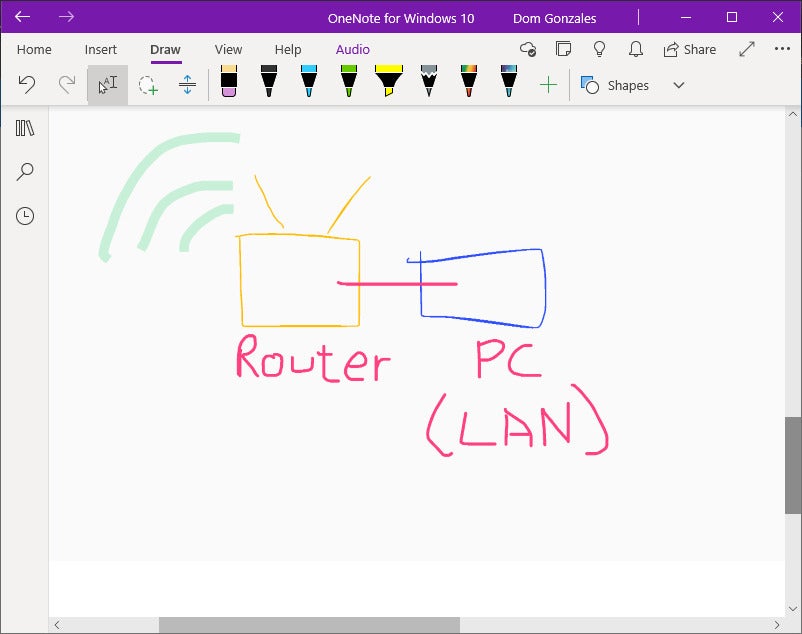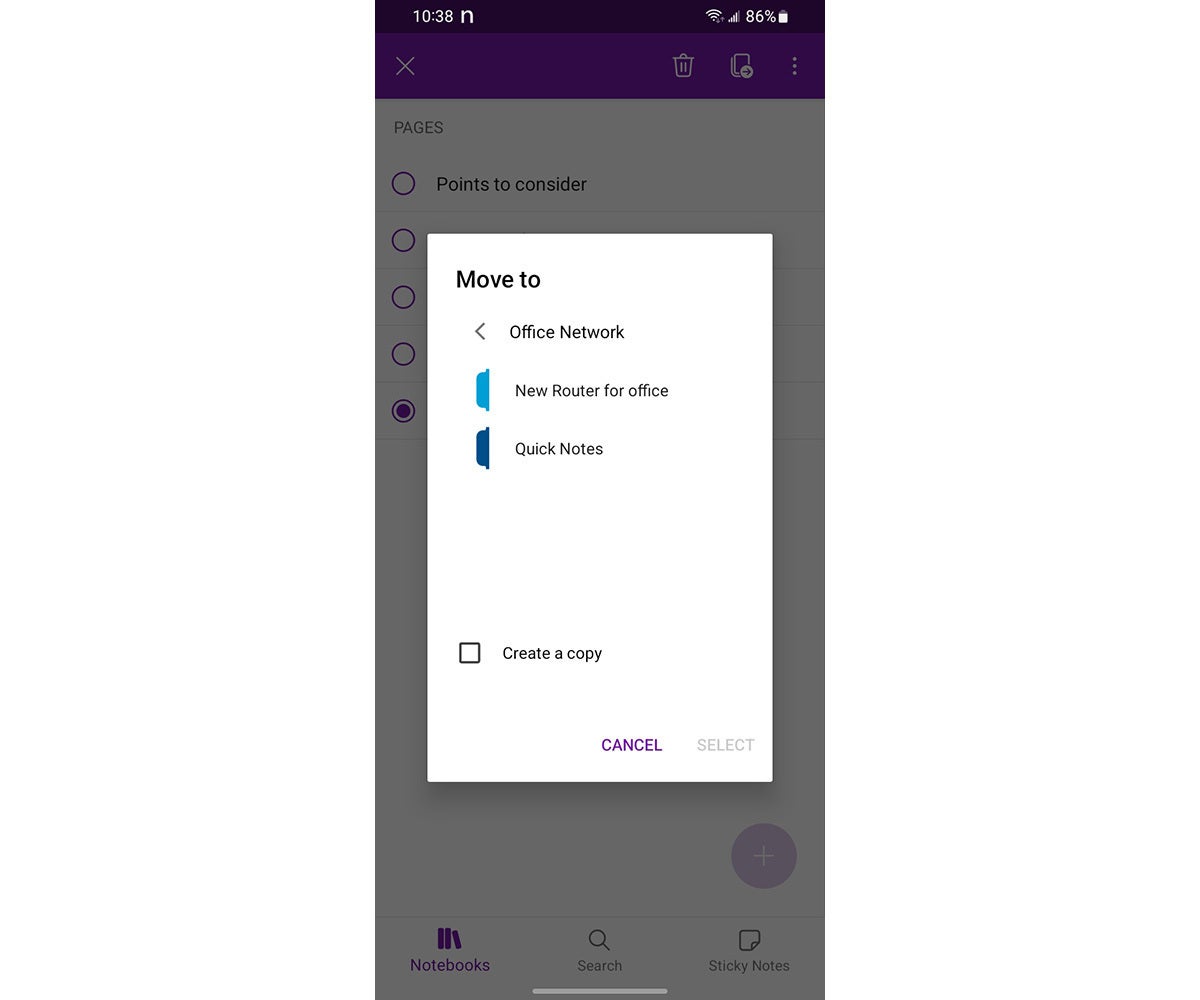Add drawings and change the page background
You can enhance your note by drawing on it or changing its design.
To add a drawing: Click the Draw tab at the top of the OneNote window. This opens a toolbar that lets you draw on the page, choosing from a range of colors and line thicknesses, or insert shapes such as ovals, rectangles, and triangles that can be used to quickly put together diagrams. You can also use these tools to draw on top of images that you’ve added to a page.
 IDG
IDG
The drawing tool lets you add quick sketches or diagrams to a note.
To change the page background: Click the View tab at the top of the OneNote window. To change the page’s background color, click the Page Color button on the toolbar that appears and select a color from the panel that opens. To add horizontal or grid lines to the background, click the Rule Lines button and make a selection.
In the OneNote mobile app: To add a drawing to a page: On an opened page or new page, tap the marker icon at the upper right. This will open a very basic drawing toolbar, which includes different markers, an eraser, and a cut-out tool. On Android you can tap and hold a marker until a panel opens that lets you change the color or thickness of the marker.
 IDG
IDG
The drawing toolbar in Android.
Organize your notes
To access your notes more efficiently, it’s worthwhile to think about how you want to organize them. You can create multiple sections within a single notebook for different projects, or create separate notebooks for different purposes. If you change your mind, it’s easy to reorganize in OneNote.
Move a section or page to a different spot in its column: Click and hold its name, then drag it up or down the list to where you want to move it.
Move or copy a page to a different section: Right-click its name and select Move/Copy. Select the section that you want to move or copy it to, and then click the Move or Copy button.
Move or copy a section to a different notebook: Right-click its name and select Move/Copy. Select the notebook that you want to move or copy it to, and then click the Move or Copy button.
Delete or rename a section or page: Right-click the name of a section or page and choose Delete Section (or Delete Page) or Rename Section (or Rename Page).
 IDG
IDG
The right-click menu for a section of a notebook. (Click image to enlarge it.)
Move a notebook: At the top of the second column, click the name of the current notebook. In the list of notebooks that appears on the Notebooks pane, click the notebook’s name and drag it up or down in the list.
Rename a notebook: At the top of the second column, click the name of the current notebook. On the Notebooks pane, right-click a notebook’s name and select Nickname Notebook.
Delete a notebook: Oddly enough, you cannot delete a notebook from the OneNote app. You have to use the OneDrive mobile app or web app. Your OneNote notebooks are saved in the Documents folder; you can delete them from the mobile app or web version of OneDrive. (But you cannot access these OneNote notebook files from File Explorer on your Windows PC — they do not appear in File Explorer.)
In the OneNote mobile app:
- To move a section or page elsewhere in the list, tap and hold the name of the section or page, then drag it up or down in the list.
 IDG
IDG
To move a section, tap and hold it, then drag it up or down.
- To copy or move a page to another section, tap and hold on the name of the page to select it. Then tap the icon of a page with an arrow over it — in Android it’s at the upper right, in iOS at the bottom of the screen. Select the section to move the page to, and also select Create a copy if you keep a copy in its current location.
- To delete a section or page, tap and hold the name of the section or page to select it, then tap the trash can icon.
- To rename a section, tap and hold on the name of the section to select it. Then tap the cursor icon — in Android it’s at the upper right, in iOS at the bottom of the screen.
- To rename a page, first tap to open it. Next, tap the first line of text at the top of the page. Delete this text and enter a new name for the page.
Search your notes
On the left toolbar, click the magnifying glass icon to open the search pane. Click the All Notebooks dropdown to narrow the search range: you can search for words or phrases through all your notebooks, the current notebook, the current section, or the current page. If you’re looking for pages that are marked with a particular tag name, click Tags. The search will look for tags that match the words you enter.
Search results appear on this pane; clicking a result will open the page that it appears on.
 IDG
IDG
Searching in OneNote.
Add multiple Microsoft accounts
You can sign in with two or more accounts at once to access notebooks belonging to each one, without having to sign out and back in with a different account. This is helpful if you have a Microsoft account for work and another for your personal use.
With a work or school account, you may see notebooks listed that you haven’t created but have been granted access to. For instance, Microsoft Teams records a team’s notes in OneNote, so if your company uses Teams, you will likely see a shared team notebook.
Sign in with another account: Click the three-dot icon at the upper right of the OneNote window and select Settings. On the Settings pane, click Accounts, and on the panel that opens, click Add account.
Add notebooks from another account: At the top of the second column of the OneNote window, click the name of the currently open notebook. On the dropdown list that opens, click More Notebooks… On the panel that opens, select the notebook(s) you want to add.
In the OneNote mobile app: In Android, tap the Notebooks icon on the lower left, then tap More Notebooks. On the next screen, tap Add account. On the next two screens, you’ll be prompted to enter the email address of your other Microsoft user account(s).
In iOS, tap the Notebooks icon on the lower left, then tap your profile picture or initials at the upper left. Tap Add or Switch Accounts, then tap Add Account. After you’ve logged into another account, tap More Notebooks on the main screen, then choose a notebook from the screen that appears.
Share and collaborate
There are two ways that you can share and collaborate with others on your notes.
Share a web link: Right-click the name of one of your notebooks, sections, or pages and select Copy Link to Notebook (or ...Section or ...Page). This generates a link to the item, copying it to the Windows clipboard. As with any ordinary web link, you can paste it in an email, instant message, document, etc.
Anyone who has a link to one of your notebooks can see all the sections in it and all the pages under each section. If it’s a link to a section, they can see only the pages under that section. A link to a single page allows them to see only that page.
Share a notebook with specific people: You can alternatively invite specific people to view and edit the notebook that’s currently open in the OneNote app. Click the Share button on the upper-right corner of the OneNote app. The Share pane will open along the right, prompting you to enter the email addresses of the people you want to share the notebook with.
 IDG
IDG
Use the Share pane to share a note with specific people only.
On this pane, “Can edit” in the dropdown means the people you’re sharing the link with can change anything about the item, such as adding elements to pages or changing the text on a page. Their changes will be synced to your copy of this item on your PC drive and OneDrive.
If the person has edit access to your notebook, they can change any sections and pages within it.
Clicking the Can edit dropdown and selecting Can view will restrict your recipients to viewing the contents of the notebook (including its sections and pages). They won’t be able to edit it.
When you click the Share button, an email will be sent to these addresses, containing a link that can be opened only by the recipients.
Stop sharing a notebook with a specific person: Click the Share button again. From the Share pane, click the recipient’s name and then click Stop sharing.
Restrictions: If you’re using OneNote under a work or school Microsoft account, sharing is governed by your organization’s rules. For instance, some organizations may not allow you to share notebooks to anyone outside your organization.
In the OneNote mobile app: To share a notebook in iOS, open the notebook, then click the three-dot icon at the upper right and select Share Notebook. On the screen that appears, you can choose either to invite specific people to the notebook or to copy a link to the notebook that you can send it to others via email, instant message, text, etc. If you choose Invite People to Notebook, a screen appears that lets you enter email addresses or names of contacts in your address book. By default, people you invite can edit the notebook. To make it view only, turn the Can Edit switch off. Tap Send in the upper-right corner to send the invitation.
If you choose Copy Link to Notebook, you can make the link View Only or View and Edit, which means anyone with the link (not just those you send it to) can make changes to the notebook. When you’ve made a selection, the link is copied to your clipboard.
In Android you can only send a copy of a page to other people, which doesn’t allow for collaboration. With the page open, tap the three-dot icon on the upper right and tap Share page on the panel that appears. On the next panel, select the format that you want to send the page in: PDF or Plain Text.
The Android share panel will open along the bottom, presenting a variety of ways that you can send the page to others. For example, if you select the Gmail app, then a new email will be created, and if you chose Plain Text on the previous panel, the text of the page will appear in the composition window of this new email. If you chose PDF previously, a pdf version of the page will be attached to the email.
In the OneNote web app: With the notebook open, click the Share button on the upper right. On the “Send link” panel that opens, there’s an area at the top where you can invite specific people to the notebook and an area at the bottom where you can copy a link to the notebook that you can send to others.
 IDG
IDG
It’s a good idea to change the web app's default “Anyone with the link can edit” settings. (Click image to enlarge it.)
In both areas, the default permissions allow anyone who clicks the link to edit the notebook — not just people you’ve invited specifically. Frankly, this is a feature you probably should not use. Instead, use one of these safer options:
- If you want to invite specific people to edit the notebook, click Anyone with the link can edit at the top of the “Send link” panel. On the panel that appears, click Specific people and then click the Apply Back on the main “Send link” screen, enter the email addresses of those you want to invite, optionally type a message to them, and click Send. Only people you’ve invited will be able to view and edit the notebook.
- If you want to allow anyone with the link to view the notebook but not edit it, click Anyone with the link can edit at the bottom of the “Send link” panel. On the panel that appears, uncheck Allow editing and click Apply. You can then copy and send the link for others to view and share.
3 extras in the OneNote web app
The web version of OneNote includes a few additional tools and options that you might find useful.
Switch between the classic and simplified Ribbon: The OneNote web app includes the classic version of the Ribbon interface, which provides a lot more detail and context about the functions on the top toolbars. This classic Ribbon interface is similar to the one in the Windows desktop version of OneNote.
 IDG
IDG
You can switch between the simplified and classic Ribbon in OneNote on the web.
To switch between the classic and simplified Ribbon interface in the web app, click the down arrow icon toward the upper right (below the Share button). On the panel that opens, select Classic Ribbon or Simplified Ribbon.
Spellcheck: This tool can be used to quickly check the spelling on a page or automatically indicate words on a page that are misspelled. You can also select a language other than English for the spell check.
At the top of the OneNote window, click the Home tab. On the toolbar, click the down arrow to the right of the abc icon and select the spell check function you want.
Page Versions: If you’re not happy with recent changes to a page, you can go back and restore an older version of it. Open the page in the main window of OneNote. At the top of the OneNote window, click the View tab, then click Page Versions in the toolbar.
In the column that lists all the pages in a section, you’ll see one or more dates that represent older saved versions of the current page listed directly below it. To view an older version, click its date to open it.
To restore an older version, right-click its date in the page list column and select Restore from the pop-up menu. This action will replace the page with this older version. What was the current version will then be moved down in the versions list to become the most recent older version.
 IDG
IDG
In the web app, you can choose an earlier version of the note to go back to.
This story was originally published in July 2019 and updated in August 2022.






![Computerworld Cheat Sheet > Microsoft > Word [Office 365]](https://images.idgesg.net/images/article/2019/02/cw_microsoft_office_365_word_cheat_sheet-100787161-small.3x2.jpg?auto=webp&quality=85,70)
![Computerworld Cheat Sheet > Microsoft > Excel [Office 365]](https://images.idgesg.net/images/article/2019/02/cw_microsoft_office_365_excel_cheat_sheet-100787152-small.3x2.jpg?auto=webp&quality=85,70)
![Computerworld Cheat Sheet > Microsoft > PowerPoint [Office 365]](https://images.idgesg.net/images/article/2019/02/cw_microsoft_office_365_powerpoint_cheat_sheet-100787158-small.3x2.jpg?auto=webp&quality=85,70)
![Computerworld Cheat Sheet > Microsoft > Outlook [Office 365]](https://images.idgesg.net/images/article/2019/02/cw_microsoft_office_365_outlook_cheat_sheet-100787153-small.3x2.jpg?auto=webp&quality=85,70)



![Microsoft > OneDrive [Office 365]](https://images.idgesg.net/images/article/2019/02/cw_microsoft_office_365_onedrive-100787148-small.3x2.jpg?auto=webp&quality=85,70)
![Microsoft > OneNote [Office 365]](https://images.idgesg.net/images/article/2019/02/cw_microsoft_office_365_onenote-100787150-small.3x2.jpg?auto=webp&quality=85,70)
![Microsoft > Planner [LOGO]](https://images.idgesg.net/images/article/2020/10/cw_microsoft_365_planner-100863840-small.3x2.jpg?auto=webp&quality=85,70)
![Computerworld Cheat Sheet > Microsoft > SharePoint [Office 365]](https://images.idgesg.net/images/article/2019/02/cw_microsoft_office_365_sharepoint_cheat_sheet-100787155-small.3x2.jpg?auto=webp&quality=85,70)